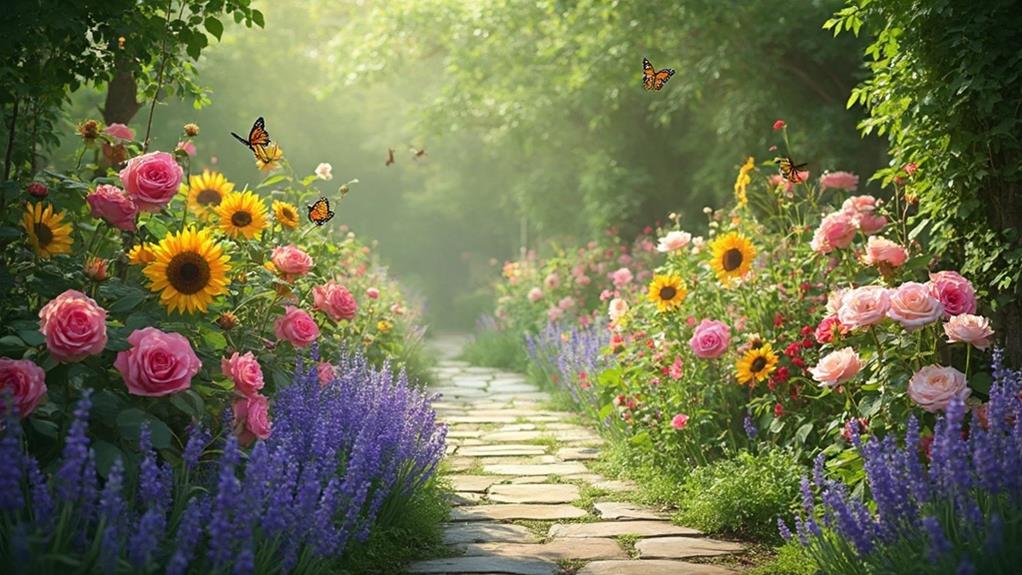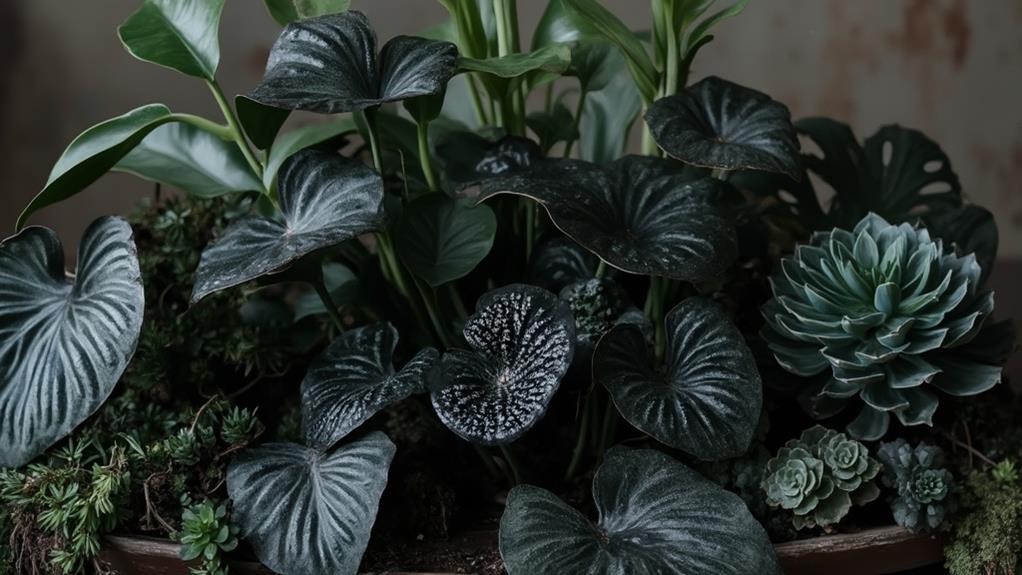When you think about enhancing your garden, colourful plants naturally come to mind. They don't just brighten up the space; they can also uplift your mood and attract beneficial pollinators. You might consider annuals like petunias or perennials such as echinacea, but there's more to creating a vibrant garden than just picking a few bright flowers. The choices you make in colour combinations and focal points can greatly impact the overall aesthetic. As you explore the various options, you may start to wonder how to achieve a harmonious design that reflects your personal style.
Key insights
- Colourful plants like petunias and zinnias enhance garden aesthetics with vibrant hues, creating a visual feast.
- Incorporating a mix of annuals and perennials ensures year-round color and interest in your garden.
- Effective soil preparation and proper watering techniques promote healthy growth and thriving plants.
- Seasonal planting guides help in selecting the right plants for specific times of the year for optimal blooms.
- Creating focal points with bold plants and water features adds depth and character to garden spaces.
Benefits of Colourful Plants

Colourful plants offer a multitude of benefits that can transform your garden into a vibrant oasis. First and foremost, their aesthetic appeal is undeniable. When you fill your garden with a variety of hues—from radiant reds to brilliant yellows—you create a visual feast that captivates the eyes and uplifts the spirit.
This stunning display not only enhances your outdoor space but also invites admiration from friends and neighbors, turning your garden into a focal point of beauty.
In addition to their visual charm, colourful plants also provide emotional benefits. Studies have shown that being surrounded by nature can reduce stress and increase feelings of happiness.
Imagine stepping into your garden, greeted by a symphony of colors and fragrances; it's an instant mood booster. Engaging with your plants, whether through watering or simply admiring them, fosters a deep connection to nature, promoting mindfulness and tranquility.
Top Annuals for Vibrancy
When you want to brighten your garden with stunning colors, choosing the right annuals is key.
Varieties like zinnias, marigolds, and petunias not only bring vibrancy but are also easy to grow with a little care.
Let's explore these colorful options and share some tips to guarantee your garden flourishes all season long!
Best Colorful Annuals
Transform your garden into a vibrant paradise by incorporating the best colorful annuals that pack a punch with their dazzling hues. When it comes to annual plant varieties, you can't go wrong with petunias. Their wide range of vibrant color palettes—from deep purples to fiery reds—makes them a must-have for any sunny space.
Another fantastic option is the zinnia, known for its cheerful blooms and resilience. They thrive in various conditions while producing an explosion of colors that can brighten up any corner.
For a more exotic flair, consider the cosmos. Their delicate, feathery foliage and bright blooms create a whimsical touch to your garden.
Marigolds are also a classic choice, offering not only a splash of gold and orange but also pest-repelling qualities that benefit your other plants.
Don't forget about the lively geranium, which provides a rich display of color and an appealing fragrance.
Growing Tips for Success
To achieve a thriving garden filled with vibrant annuals, proper care and attention are key. Here are some essential tips to help you succeed:
1. Soil Preparation: Start with well-draining soil enriched with organic matter. Amend the soil with compost or aged manure to boost nutrient levels and improve moisture retention.
2. Light Requirements: Understand the light needs of your chosen annuals. Most thrive in full sun (at least 6 hours of direct sunlight), while some prefer partial shade.
Position your plants accordingly to maximize their growth and vibrancy.
3. Watering: Keep the soil consistently moist but not soggy. Deep watering encourages root development. Aim for about 1 inch of water per week, adjusting for rainfall.
4. Fertilization: Feed your annuals with a balanced fertilizer every 4-6 weeks during the growing season.
This promotes lush foliage and abundant blooms, enhancing the overall beauty of your garden.
Hardy Perennials to Consider
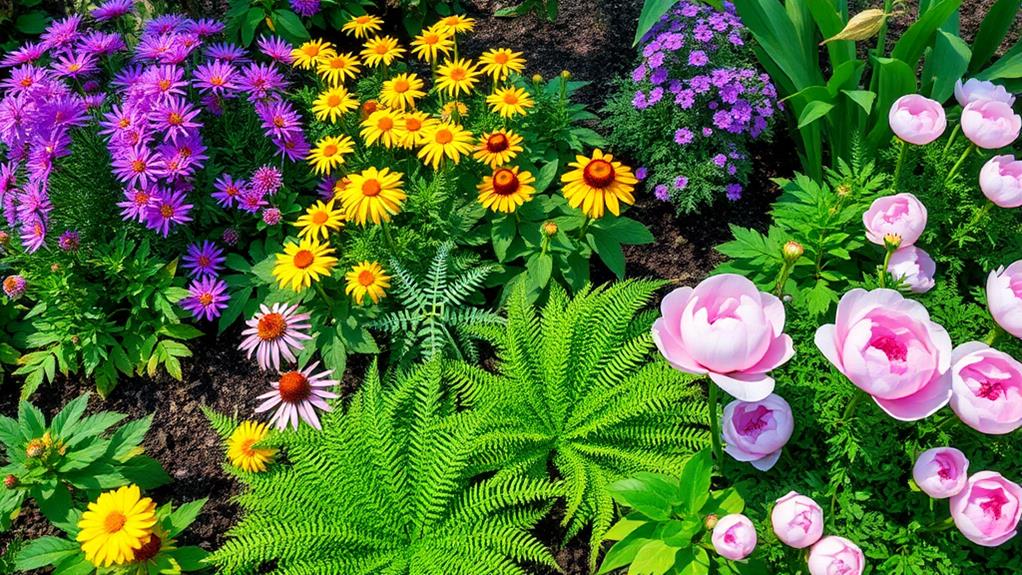
When you're planning your garden, hardy perennials are a fantastic choice that brings both beauty and resilience.
These plants not only survive through changing seasons but also provide vibrant colors year after year with minimal effort on your part.
Let's explore the benefits of these reliable favorites and discover some top choices that will thrive in your garden.
Benefits of Hardy Perennials
Hardy perennials are the unsung heroes of any vibrant garden, offering a multitude of benefits that make them a wise choice for both novice and seasoned gardeners.
These resilient plants flourish in various climates, require less maintenance, and provide lasting beauty year after year. Here are some compelling reasons to embrace these hardy varieties:
- Seasonal Stability: Hardy perennials adapt well to changing seasons, ensuring your garden remains colorful throughout the year.
- Low Maintenance: Once established, their perennial care is minimal, saving you time and effort in the long run.
- Cost-Effective: Investing in these plants means fewer replacements and a more sustainable garden budget, as they return season after season.
- Biodiversity Support: By planting hardy perennials, you create habitats for beneficial insects and wildlife, promoting a healthier ecosystem.
Incorporating these hardy varieties into your garden can lead to a flourishing space filled with natural beauty.
Whether you're looking to fill gaps or create cohesive designs, these plants are a fantastic choice for enhancing your outdoor landscape.
With the right perennial care, your garden will thrive and dazzle for years to come!
Top Choices for Gardens
Choosing the right hardy perennials can transform your garden into a vibrant sanctuary filled with color and life. When it comes to garden design, selecting the right plants is essential. You'll want to take into account both aesthetics and hardiness, ensuring your selections thrive in your local climate. Here are some top choices to take into account:
| Plant Name | Key Features |
|---|---|
| Echinacea | Drought-tolerant, attracts pollinators |
| Rudbeckia | Bright yellow blooms, long-lasting |
| Salvia | Fragrant foliage, colorful spikes |
These perennials not only provide beautiful blooms but also require minimal maintenance once established. Incorporating them into your garden can enhance your outdoor space's overall appeal. As you contemplate your plant selection, remember to mix different heights and colors for visual interest, ensuring your garden remains enchanting throughout the seasons. Hardy perennials like these can also support local wildlife, making your garden a haven for nature. With thoughtful choices, you'll create a stunning landscape that brings joy and beauty year after year.
Tips for Planting Success
How can you guarantee your garden thrives and bursts with color? It all starts with a solid foundation and effective planting techniques. Here are four vital tips to help you achieve planting success:
- Soil Preparation: Before planting, test your soil's pH and nutrient levels. Amend it with organic matter like compost to enhance drainage and fertility.
- Choose the Right Location: Each plant has its own sunlight and space requirements. Assure you understand the needs of your chosen plants and position them accordingly.
- Timing Matters: Pay attention to the seasons. Planting at the right time not only promotes healthy growth but also maximizes blooming potential.
- Water Wisely: Consistent moisture is essential, especially during the establishment phase. Water deeply but infrequently, encouraging roots to grow strong and deep.
Colour Combinations That Work
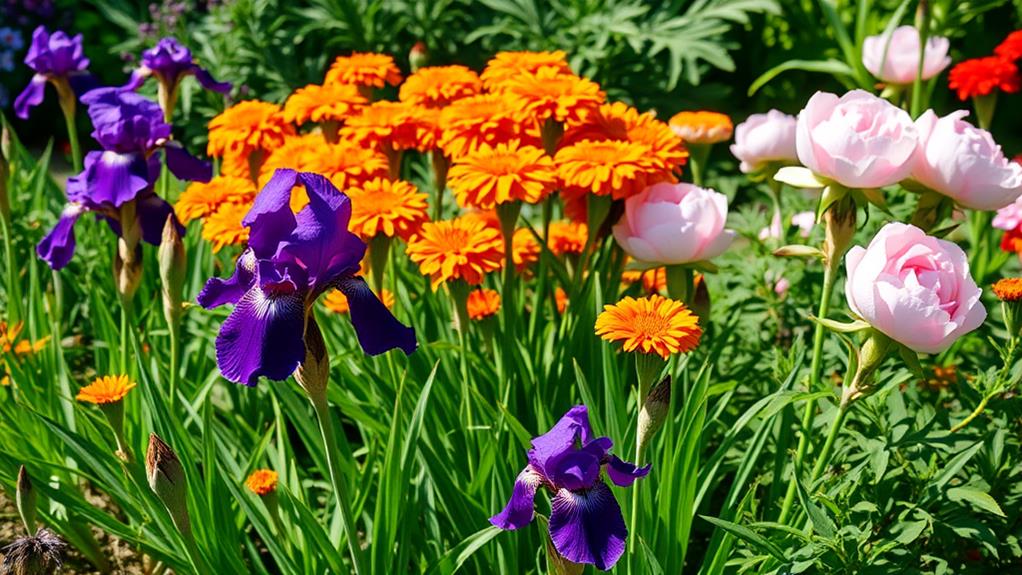
A vibrant garden isn't just about healthy plants; it's also about the artful interplay of colors that can elevate your outdoor space. Understanding how to mix complementary colors and contrasting hues can transform your garden into a stunning visual feast.
Here's a handy guide to some effective color combinations:
| Color 1 | Color 2 | Effect |
|---|---|---|
| Blue | Orange | Energetic and vibrant |
| Yellow | Purple | Cheerful elegance |
| Red | Green | Bold and revitalizing |
| Pink | White | Soft and romantic |
| Teal | Coral | Warm and inviting |
When choosing your plants, think about how these colors interact. Complementary colors, like blue and orange, create a lively contrast that draws the eye. On the other hand, contrasting hues like yellow and purple bring a sense of richness and depth to your garden. Don't be afraid to experiment! Mixing these colors thoughtfully will help you achieve a harmonious yet dynamic look that reflects your personal style. Remember, your garden is a canvas—paint it with the colors that inspire you!
Maintaining Your Colourful Garden
Maintaining a colourful garden requires a keen eye and a commitment to nurturing your plants throughout the seasons.
To keep your vibrant display thriving, focus on a few essential practices that promote soil health and effective pest management.
Here's a quick checklist to guide you:
- Soil Testing: Regularly test your soil to guarantee it has the right pH and nutrient levels. Amend as needed with compost or fertilizers to boost fertility.
- Watering Wisely: Water your plants deeply but infrequently. This encourages strong root development and helps prevent diseases.
- Pest Monitoring: Keep an eye out for pests. Early detection is key! Use organic pest management techniques like introducing beneficial insects or using insecticidal soap.
- Pruning and Deadheading: Regularly prune your plants and deadhead spent flowers. This not only encourages new blooms but also improves air circulation, reducing the risk of fungal diseases.
Seasonal Planting Guide
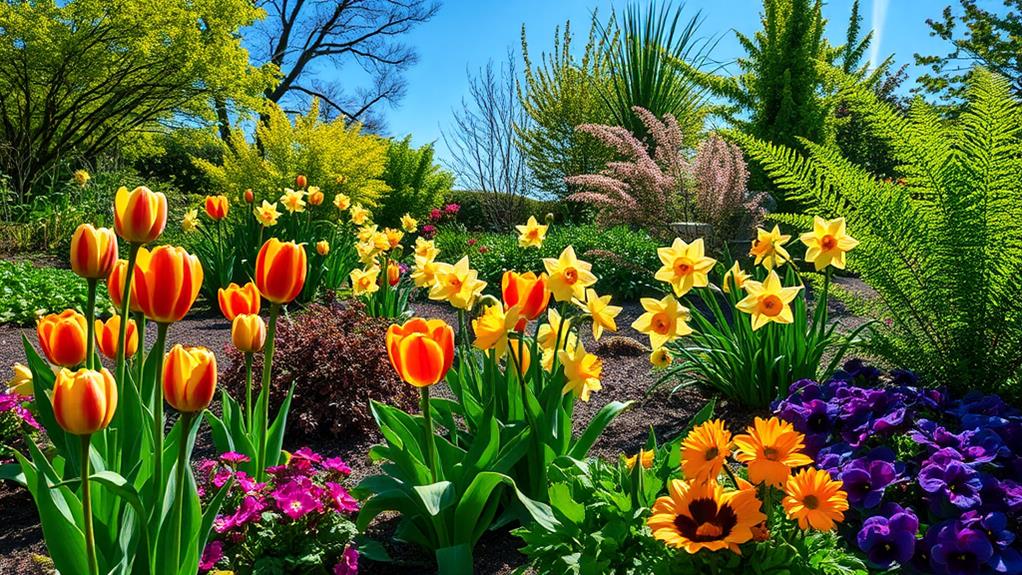
To create a stunning garden that bursts with color throughout the year, understanding the seasonal planting guide is essential.
Start with spring, when you can plant vibrant annuals like petunias and marigolds. This season is all about new growth, so capitalize on seasonal trends by incorporating perennials like daylilies and peonies for lasting beauty.
As summer rolls in, consider plants that thrive in the heat. Sunflowers and zinnias not only add color but also attract pollinators. Keep your planting schedule on track by deadheading spent blooms, encouraging more flowers to emerge.
When fall arrives, think about foliage and texture. Ornamental grasses and asters will provide stunning visuals as the leaves change.
It's also a great time to plant spring-blooming bulbs like tulips and daffodils.
Creating Focal Points in Gardens
In the heart of every stunning garden, focal points draw the eye and create a sense of harmony. By incorporating focal point techniques, you can enhance your garden's visual balance and bring it to life.
Here are four effective ways to create enchanting focal points:
- Statues and Ornaments: Add a striking statue or a whimsical ornament that reflects your personality. This creates a conversation starter.
- Bold Plants: Use a large, vibrant plant or a cluster of colorful flowers to attract attention. Think of something like a sunflower or a striking dahlia that stands out.
- Water Features: Incorporate a fountain or a small pond. The sound of water and its reflective surface naturally draws people in.
- Pathways: Design a meandering path leading to a specific spot, like a cozy bench or a beautiful flower bed. This guides visitors through your garden while highlighting key areas.
Frequently Asked Questions
What Are the Best Soil Types for Colourful Garden Plants?
When you're selecting soil for vibrant plants, consider the soil pH and drainage requirements.
Most colorful plants thrive in slightly acidic to neutral pH, ideally between 6.0 and 7.0.
Make certain your soil has good drainage to prevent waterlogging, which can damage roots.
You might mix organic matter like compost to improve texture and fertility.
How Do I Attract Pollinators to My Colourful Garden?
To attract pollinators to your garden, plant a variety of native flowers that bloom at different times. These plants provide essential nectar and pollen.
Create diverse pollinator habitats by incorporating native grasses and shrubs alongside your flowers.
Avoid pesticides; instead, use natural methods for pest control.
You'll find that a healthy environment encourages bees, butterflies, and other pollinators to thrive, enhancing the beauty and vibrancy of your garden.
Can Colourful Plants Thrive in Shaded Areas?
Yes, colourful plants can thrive in shaded areas!
You can choose shade-tolerant varieties like hostas, ferns, and astilbes that offer vibrant foliage, bringing life to darker corners of your garden.
These plants not only survive but flourish, providing a lush backdrop to your space.
By mixing different textures and colors, you create an eye-catching display even without direct sunlight.
What Are the Most Common Pests Affecting Vibrant Garden Plants?
In your vibrant garden, pests can feel like unwelcome guests crashing a party.
Aphids, spider mites, and whiteflies often invade, threatening your plants' beauty. Effective pest control is essential to keep your garden thriving.
You can embrace organic treatments like neem oil or insecticidal soap, which act like a protective shield, ensuring your colorful flora flourishes.
How Can I Propagate My Colourful Garden Plants?
To propagate your plants, start with seed starting by selecting healthy seeds and planting them in a suitable medium.
Keep the soil moist and provide adequate light.
Alternatively, use cutting techniques by taking a healthy stem cutting, removing lower leaves, and placing it in water or soil.
Make sure you maintain humidity and warmth until roots develop.
With patience and care, you'll soon see new growth, expanding your vibrant garden beautifully!
Summary
By nurturing a colourful garden, you're not just planting flowers; you're crafting your own vibrant tapestry, much like an artist with a palette. Imagine stepping outside to a kaleidoscope of blooms, where each petal tells a story of joy and tranquility. Just as a well-composed painting brings a room to life, your garden can transform your outdoor space into a sanctuary. Embrace the beauty of colour, and watch your connection with nature flourish season after season.











